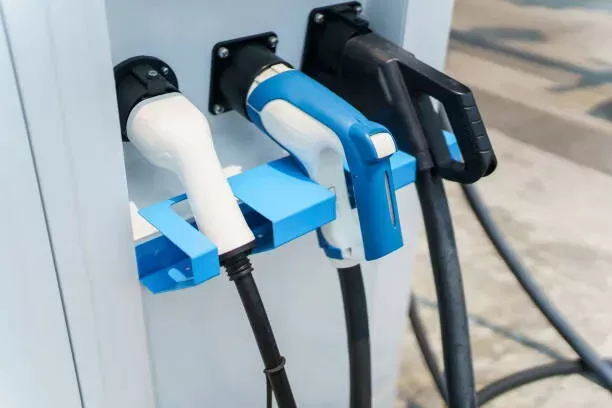Notifications

7 minutes, 44 seconds
-13 Views 0 Comments 0 Likes 0 Reviews

As the electric vehicle (EV) movement accelerates worldwide, the demand for accessible and efficient charging infrastructure has never been greater. Among the various charging options available, Level 2 AC charging stations have emerged as a practical, cost-effective solution for everyday EV needs. They strike a perfect balance—faster than Level 1 chargers, yet more affordable and versatile than Level 3 DC fast chargers.
Found in homes, offices, public parking lots, and commercial hubs, Level 2 chargers support millions of EV drivers with reliable daily charging. But what exactly is a Level 2 EV charger? How does it work, and why is it essential to the EV ecosystem? Let’s explore.
A Level 2 EV charger operates using a 240-volt power supply—similar to what powers household appliances like dryers or ovens. This allows it to deliver significantly more electricity than a Level 1 charger, which uses a standard 120-volt outlet.
Typically rated between 16 and 80 amps, most home installations operate around 32 to 40 amps. Depending on the EV and charger model, a Level 2 charger can provide 12 to 60 miles of range per hour. For example, an EV with a 60 kWh battery can be fully recharged in 4 to 8 hours, making overnight charging at home or daytime charging at work convenient and efficient.
One of the biggest advantages of Level 2 charging is the ability to install it at home. With access to a 240V circuit—often already available in garages or laundry areas—homeowners can enjoy the freedom of overnight charging.
Some considerations for home installation:
Electrical Upgrades: May require a panel upgrade or a dedicated circuit.
Professional Installation: Recommended for safety and compliance.
Modern Level 2 chargers often include smart features:
Wi-Fi and mobile app control
Scheduled charging during off-peak hours
Load balancing to manage home energy usage
Real-time energy usage tracking
With these capabilities, your home charger becomes more than a plug—it’s a personalized energy management tool.
The performance of a Level 2 charger depends on:
The Charger’s Power Output (3 kW to 19.2 kW in the U.S., up to 22 kW in Europe)
The EV’s Onboard Charger Capacity
For example, if you plug into a 19.2 kW charger, but your EV only accepts 11 kW, charging will be capped at 11 kW.
Typical range gain is 10 to 75 miles per hour, depending on the setup—up to 19 times faster than Level 1 chargers, which only add 3 to 5 miles per hour.
Though not as fast as DC fast chargers, which can reach 80% in 30 minutes, Level 2 is ideal for daily use and far more affordable for long-term installations.
Level 2 chargers are common in public and semi-public spaces, making it easy for EV drivers to top off while running errands or at work. You’ll frequently find them at:
Office buildings and campuses
Shopping malls and hotels
Restaurants and entertainment venues
Hospitals and municipal parking lots
A couple of hours on a Level 2 charger while dining or shopping can add 40–80 miles of range—often enough for multiple days of local driving. For businesses, providing charging is also a powerful incentive to attract eco-conscious customers and employees.
Installing multiple Level 2 chargers—especially in apartment complexes, office parks, or public areas—requires thoughtful load management to avoid overloading the electrical system.
Solutions include:
Dynamic load balancing: Distributes power efficiently among chargers.
Load shedding: Temporarily reduces power draw during peak usage.
Smart energy control: Ensures system safety and efficiency.
Residential setups may also require electricians to assess total home load to determine if a charger can be safely integrated.
Level 2 chargers use standardized connectors for broad compatibility:
North America: SAE J1772 (used by nearly all EVs; Tesla requires an adapter)
Europe: Type 2 (Mennekes), natively supported by most vehicles, including Tesla
Most public Level 2 stations are network-connected, supporting:
Mobile app access and RFID authentication
Payment integration
Real-time monitoring and maintenance alerts
This networked approach makes charging easy, transparent, and accessible for all users.
Charger hardware: $400–$900
Professional installation: $500–$2,000, depending on electrical work needed
Hardware: $1,500–$5,000+ per unit
Installation: $2,000–$10,000+, depending on site complexity
Good news: Government incentives and utility rebates can significantly reduce costs. In the U.S., federal tax credits and various state-level programs support both residential and commercial charger installations.
Level 2 chargers contribute directly to reducing vehicle emissions, curbing air pollution, and decreasing reliance on fossil fuels. When powered by renewable energy—like solar—the environmental benefits grow even stronger.
For businesses and institutions, EV charging can:
Enhance green credentials (ESG performance)
Increase customer dwell time
Attract sustainability-focused clientele and tenants
As EV adoption expands, so will innovations in Level 2 technology. Look for:
Faster Level 2 chargers with higher outputs
Vehicle-to-grid (V2G) bidirectional power capabilities
AI-driven load balancing for multi-unit systems
Integration with solar and battery storage
Universal payment platforms for simplified access
Level 2 EV chargers are a cornerstone of the clean transportation future. By offering faster, smarter, and more accessible charging at home and in public, they eliminate range anxiety and support the daily needs of EV drivers.
Whether you’re an individual installing a charger at home or a business investing in public infrastructure, Level 2 charging provides a cost-effective, scalable solution that keeps the world moving—cleanly, quietly, and efficiently.Know more about China Manufacturer
China EV Chargers EV Charger Manufacturer EV Charging Solutions

